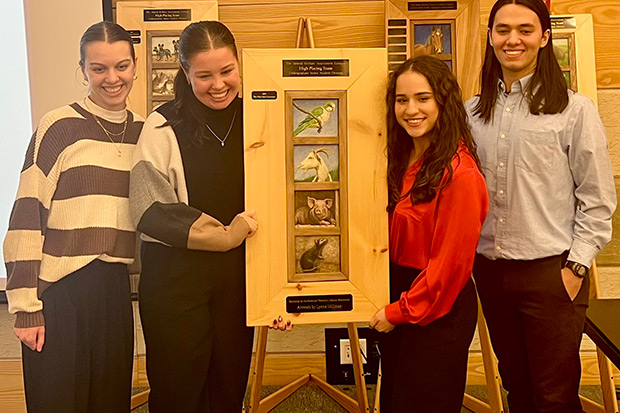Students, veterinarians address animal welfare scenarios during annual contest
Animal welfare means not only ensuring disease prevention and treatment, but also proper housing and management. Considering all relevant factors related to the health, environment, and care of the animal can become complicated very quickly.
Each year, the AVMA Animal Welfare Assessment Contest, or AWJAC, seeks to help undergraduates, veterinary students, and graduate students become engaged and interested in animal welfare and understand the complex dynamics. AVMA member veterinarians and veterinary technicians also have an opportunity to participate.
The 23rd annual event took place November 17-19 at the University of Wisconsin-River Falls. Participants completed in-person assessments of the welfare of animals in a variety of scenarios, including laboratory rats, farmed bison, cage-free laying hens, and tortoises in a zoo. In doing so, participants had an opportunity to practice their assessment skills and present their findings to an expert panel of veterinarians and scientists.
Founded at Michigan State University in 2001, the Animal Welfare Judging and Assessment Contest was modeled after traditional livestock, horse and meat judging competitions. With assistance through continued educational funding from partner Merck Animal Health, today’s contest brings students together from around the world. This year, more than 230 participants attended, representing 24 universities from across North America and Europe.
Megan R. LaFollette, PhD, is executive director at the 3Rs Collaborative where she works to advance better science for both people and animals. Dr. LaFollette, a previous participant of the contest, served as one of the judges for the AWJAC this year and is chair of the AVMA Steering Committee on Human-Animal Interactions.
LaFollette explained that the contest encourages more people to think about animal welfare in a scientifically based manner with the animal’s experiences in mind, while fostering open dialogue about animal welfare in a field that can often be polarizing.
“As a student studying welfare, it provided me a great opportunity and structure to apply my knowledge about animal welfare,” LaFollette said. “It gave us practice with communicating about animal welfare in a succinct, convincing, and evidence-based manner. As a winner in the graduate division that year, the competition also allowed me to demonstrate my skills to my future employer.”
Katy Proudfoot, PhD, an associate professor and director of the Sir James Dunn Animal Welfare Centre at the University of Prince Edward Island Atlantic Veterinary College, volunteered as a coach.
She enjoys going to the contest to support her students and watch them network with other veterinary students and animal welfare experts.
“Students are able to develop and use their critical thinking skills to judge the welfare of animals in different scenarios, which gives them important skills and knowledge that they may not get in their veterinary curriculum,” Dr. Proudfoot said, who is the representative for the American Association of Veterinary Medical Colleges on the AVMA Animal Welfare Committee.
Winners of the 2023 contest are as follows:
Live Assessment, Individual: Undergraduate, Junior Division—Kaylyn Choi, University of Illinois; Undergraduate, Senior Division—Nick Prosek, University of Nebraska-Lincoln; Veterinary Student Division—Sara Pantel, Tufts University; and Graduate Division—Margaret Schatte, Colorado State University.
Live Assessment, Teams: Undergraduate, Junior Team—Texas A&M University; Undergraduate, Senior Team—North Carolina State University; Veterinary Student Team—Atlantic Veterinary College, Team 1; and Graduate Team—The Ohio State University.
Veterinary Student Division, Individual: First place—Miranda Bie, Ontario Veterinary College, Team Gold; second place—Catherine LeBlond, Atlantic Veterinary College, Team 1; third place—Abigail Penney-Wiseman, Atlantic Veterinary College, Team 2; fourth place—Shyanne Hall, University of Minnesota; and fifth place—Lucy Morrison, Ontario Veterinary College, Team Red.
Veterinary Student Division, Teams: First place—Atlantic Veterinary College, Team 1; second place—Ontario Veterinary College, Team Gold; third place—Ontario Veterinary College, Team Red; fourth place—Michigan State University; and fifth place—Atlantic Veterinary College, Team 2.
Graduate Division, Individual: First place—Madison Pinkerton, Purdue University; second place—Madison Bacon, University of Minnesota; third place—Hayley Sutherland, Purdue University; fourth place—Elizabeth Schafer, Purdue University; and fifth place—Madeline Winans, The Ohio State University.
Graduate Division, Teams: First place—The Ohio State University; second place—Purdue University; third place—University of Guelph; fourth place—University of Minnesota; and fifth place—Texas A&M University.
Undergraduate, Senior Division, Individual: First place—Lauren Peterson, University of Minnesota, Team Gold; second place—Leigh Herbst, University of Minnesota, Team Gold; third place—Eliza Ohm, University of Minnesota, Team Gold; fourth place—Alli Matzek, University of Wisconsin-River Falls, Team 2; and fifth place—Iris Mackenzie, The Ohio State University.
Undergraduate, Senior Division, Teams: First place—University of Minnesota, Team Gold; second place—University of Minnesota, Team Maroon; third place—University of Wisconsin-River Falls; fourth place—Texas A&M University; and fifth place—The Ohio State University.
Undergraduate, Junior Division, Individual: First place—Anna Ridenour, University of Minnesota; second place—Austin Davis, University of Illinois, Team Blue; third place—Evie Anderson, Colorado State University, Team Green; fourth place—Laura Boase, University of Minnesota; and fifth place—William Torres, Texas A&M University.
Undergraduate, Junior Division, Teams: First place—Colorado State University, Team Green; second place—University of Minnesota; third place—Texas A&M University; fourth place—University of Illinois, Team Blue; and fifth place—North Carolina State University.
Visit the AWJAC website for more information and a full list of supporting partners.
A version of this story appears in the January 2024 print issue of JAVMA




